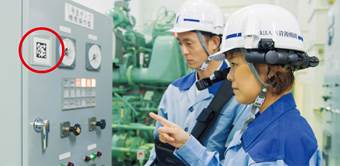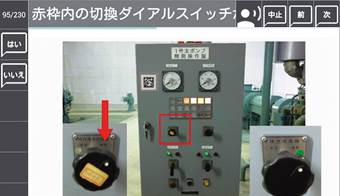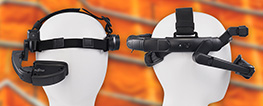Archived content
NOTE: this is an archived page and the content is likely to be out of date.
Remote Support Improves Maintenance and Inspection Efficiency Case Studies Demonstrate Power of Worker Efficiency
Many companies and organizations want to transfer the skills and experience of their senior maintenance and inspection workers to new staff to ensure everyone is equally skilled. They want to be able to guarantee the quality and efficiency of the work with a limited number of skilled and experienced people. Fujitsu is helping these groups deploy a Worker Efficiency that utilizes the company’s head mounted displays (HMDs). This article follows three case studies to look at the potential of this solution.

Maintenance and inspection is essential for maintaining the function and capability of equipment at manufacturing plants as well as social infrastructure such as roads and bridges. To get the best performance out of manufacturing equipment and social infrastructure, regular inspections must be carried out in a timely manner and ap-propriate repairs and adjustments must be done swiftly when evidence of faults is found.
The problem is that the majority of maintenance and inspection work is manual. Each piece of equipment and infrastructure is different as well, so uniform handling of issues is difficult and much of the work requires the skills and knowledge of experienced workers.
Japanese society is being challenged by an aging population in many ways and the impact is also being felt across engineering including maintenance and inspections. A major issue faced by worksites is how to pass on the skills and experience of senior workers to new employees before the main wave of retirements begin.
In fact, many workers are already reaching retirement age, so the work backlog and a drop-off in quality are starting to occur due to shortages in the necessary skills and experience. This is occurring just as the equipment and social infrastructure installed during the boom period is starting to age, with a corresponding increase in the volume of required maintenance and inspection work. As a result, many industries are looking to put systems in place to ensure maintenance and inspection work is carried out properly, regardless of the experience and capabilities of the workers involved.
To help worksites meet this challenge, Fujitsu combined the Internet of Things (IoT), augmented reality (AR) and other information and communications technologies to launch its FUJITSU IoT Solution Worker Efficiency in May 2015. Built around the company’s FUJITSU IoT Solution Head Mounted Display (HMD), this solution integrates several of the company’s other solutions to provide comprehensive support for those managing maintenance and inspection tasks on site.
Digitalizing manuals and instruction sheets, and using AR technologies to display the information on HMDs, the Worker Efficiency enables intuitive use of documents in the workplace. HMDs also include cameras, microphones and speakers to connect worksites with remote locations via image and voice, so that they can become an integral part of systems built to provide remote support.
The following three case studies demonstrate the potential of Fujitsu’s Worker Efficiency.
Case Study 1. Lake Biwa Development Integrated Operation & Maintenance Office, Japan Water Agency
AR-linked machine operation manuals and HMD display, coupled with remote support, ensures a rapid and reliable emergency response from all staff
Lake Biwa Development Integrated Operation & Maintenance Office, Japan Water Agency, is a public agency entrusted with ensuring a stable supply of water to the local region and protecting the region from damage in the event of flood. The agency manages a network of 14 drainage pump stations over a distance of about 235 km around the shores of Lake Biwa. To mitigate flood damage in low-lying areas when typhoons or storms bring heavy rainfall, it operates floodgates and drainage pumps at the pump stations to return water to the lake and prevent backflow into surrounding areas.
Drainage pump control panels have a complex system of switches, and operating them proficiently requires advanced expertise. When water levels rise quickly due to sudden downpours or typhoons, the 14 drainage pump stations have to be operated in rapid succession depending on conditions. However, there are only a limited number of specialists able to do the job. To enable non-specialist workers to operate the equipment, the agency provides operation manuals at each station. However, paper manuals cannot effectively convey the finer nuances of the task and they must be held by hand, which makes it difficult to multitask.
The agency decided to digitalize its manuals for use with HMDs, and create an environment enabling two-way communication of work instructions and checks between the stations and the management team. They wanted an HMD-based solution to provide support to workers in the field, so they deployed FUJITSU Software Interstage AR Processing Server as an AR integration platform, together with a remote support system, the FUJITSU Enterprise Application AZCLOUD SaaS teraSpection work information management system, in addition to a work instruction system.
The solution adopted by the agency used nine HMDs. With each pump and control panel tagged with AR markers, the HMD cameras recognized the different markers and displayed operating instructions in the form of instruction cards on the HMD displays. As a result, new workers who had not touched the control panels previously, and office staff, were able to successfully operate the equipment. One of the deciding factors in the agency choosing Fujitsu’s solution was the fact that only Fujitsu had HMDs that could both recognize individual AR markers and display corresponding instructions.
Being able to switch to remote assistance when unexpected problems occur, or when the required task cannot follow the procedures, helps personnel respond flexibly to each situation. Using the camera, microphone and speaker functions of the HMDs, workers are also able to share workplace situations in real time with the management office and headquarters, and ask for real-time guidance from offsite specialists.
Compared with the previous paper-manual-based operating procedures, this new solution reduced the time needed for operating the pumps by 31%, and for writing reports by 89%. Both initial costs and running costs have reportedly dropped by 40%.
Case Study 2. Construction Company “A”
Worker Efficiency enables efficient management of multiple construction sites with fewer staff
This second case study involves a local construction company headquartered in the Tohoku region of Japan and renowned for its civil engineering work. More than five years after the Great East Japan Earthquake, recovery and restoration work is still continuing across the area and construction companies are perennially short of work-ers.
This company was keen to use the latest information and communication technologies to support, and improve the efficiency of, its staff managing the progress of jobs. To prepare progress reports for customers, staff had to physically visit every site. After each visit they would return to the office to prepare the report, so they were losing a lot of productive time in travel.
Administration staff would go to each site and use a camera to record progress of the work, but the company decided to have onsite workers take the photos instead. They felt that deploying Fujitsu’s Worker Efficiency would improve efficiency of the work. They chose the Fujitsu solution because of its remote support functionality enabling real-time sharing of worksite images with the office and also because it was built around Fujitsu’s HMDs that had an enviable reputation for outdoor use, being waterproof and dustproof.
Once in operation, the construction company found the solution was even more effective than expected. When preparing reports onsite, the workers would wear the HMDs and share video in real time with administration staff in the office.Administration staff were able to save the captured video to computer for their reports straight away. As a result, administration staff no longer had to go into the field, whereas previously they had to visit multiple sites for the preparation of reports. The new solution enabled a dramatic reduction in travel time and related costs.

Checking AR-marker-linked work procedures

Work procedure card
When operational problems occur, workers are also able to use the HMD remote support to quickly check issues that they are uncertain about. Even when there are no experienced workers onsite, operations can progress smoothly. The solution also had a significant upside for customers. In the past, the company would periodically ask customers to visit the workplace to confirm progress, but with the remote support function, customers are now able to review the work progress without needing to go onsite. Deployment of the solution, aimed at improving the efficiency of site inspections, also led to improved customer satisfaction.
Case Study 3. Infrastructure Company “B”
Worker Efficiency designed for outdoor work enables hands-free operation with waterproof, dustproof devices
The third case study involves an infrastructure company that chose Fujitsu’s Worker Efficiency for the maintenance and inspection of base stations exposed to the elements.
Base station equipment is installed in outdoor locations, and the towers themselves often extend dozens of meters into the air. Overhead ladders and catwalks used to access these locations are not covered, so the devices carried by engineers conducting maintenance and inspection, must not only be able to withstand gale-force rain, but also be able to clearly display work instructions in bright sunlight. Rather than simply being water resistant to the JIS C 0920 IPX4 standard, mobile devices need to be capable of withstanding water jets (JIS C 0920 IPX5) and water immersion (JIS C 0920 IPX7).
Because work is conducted outdoors and at heights, hands-free operation of devices is also an absolute requirement. For this reason, in order to deliver quality and efficiency improvements, the infrastructure company wanted a system that uses AR technologies to deliver operational instructions and that accepts voice input of the inspection results.
The company selected Fujitsu’s Worker Efficiency because it met all the requirements. To improve work efficiency while enabling safe, hands-free operation, they saved their manuals and digital instructions to microSD cards for display through the HMDs when needed.
One of the benefits of deploying the Worker Efficiency was that it reduced the length of time workers spent on the towers. Whereas previously the workers had to use cell phones to call the office whenever they ran into difficulties, they can now display and search the manuals through the HMD display and quickly fix problems themselves. In addition to improving productivity, by cutting the time needed for working at heights the solution should also offer improvements from an occupational health and safety perspective.
Fujitsu’s Worker Efficiency helps to overcome various challenges relating to maintenance and inspection work. In addition to the applications detailed in the above case studies in flood control, civil engineering and telecommunications, the solution should be useful in any industry that requires onsite work. This is certainly something that companies and organizations should seriously consider.
We want to hear from you.


